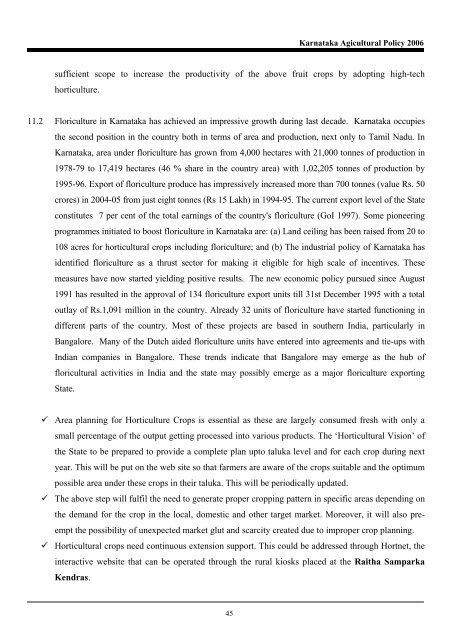Karnataka Agricultural Policy - Institute for Social and Economic ...
Karnataka Agricultural Policy - Institute for Social and Economic ...
Karnataka Agricultural Policy - Institute for Social and Economic ...
You also want an ePaper? Increase the reach of your titles
YUMPU automatically turns print PDFs into web optimized ePapers that Google loves.
<strong>Karnataka</strong> Agicultural <strong>Policy</strong> 2006<br />
sufficient scope to increase the productivity of the above fruit crops by adopting high-tech<br />
horticulture.<br />
11.2 Floriculture in <strong>Karnataka</strong> has achieved an impressive growth during last decade. <strong>Karnataka</strong> occupies<br />
the second position in the country both in terms of area <strong>and</strong> production, next only to Tamil Nadu. In<br />
<strong>Karnataka</strong>, area under floriculture has grown from 4,000 hectares with 21,000 tonnes of production in<br />
1978-79 to 17,419 hectares (46 % share in the country area) with 1,02,205 tonnes of production by<br />
1995-96. Export of floriculture produce has impressively increased more than 700 tonnes (value Rs. 50<br />
crores) in 2004-05 from just eight tonnes (Rs 15 Lakh) in 1994-95. The current export level of the State<br />
constitutes 7 per cent of the total earnings of the country's floriculture (GoI 1997). Some pioneering<br />
programmes initiated to boost floriculture in <strong>Karnataka</strong> are: (a) L<strong>and</strong> ceiling has been raised from 20 to<br />
108 acres <strong>for</strong> horticultural crops including floriculture; <strong>and</strong> (b) The industrial policy of <strong>Karnataka</strong> has<br />
identified floriculture as a thrust sector <strong>for</strong> making it eligible <strong>for</strong> high scale of incentives. These<br />
measures have now started yielding positive results. The new economic policy pursued since August<br />
1991 has resulted in the approval of 134 floriculture export units till 31st December 1995 with a total<br />
outlay of Rs.1,091 million in the country. Already 32 units of floriculture have started functioning in<br />
different parts of the country. Most of these projects are based in southern India, particularly in<br />
Bangalore. Many of the Dutch aided floriculture units have entered into agreements <strong>and</strong> tie-ups with<br />
Indian companies in Bangalore. These trends indicate that Bangalore may emerge as the hub of<br />
floricultural activities in India <strong>and</strong> the state may possibly emerge as a major floriculture exporting<br />
State.<br />
Area planning <strong>for</strong> Horticulture Crops is essential as these are largely consumed fresh with only a<br />
small percentage of the output getting processed into various products. The ‘Horticultural Vision’ of<br />
the State to be prepared to provide a complete plan upto taluka level <strong>and</strong> <strong>for</strong> each crop during next<br />
year. This will be put on the web site so that farmers are aware of the crops suitable <strong>and</strong> the optimum<br />
possible area under these crops in their taluka. This will be periodically updated.<br />
The above step will fulfil the need to generate proper cropping pattern in specific areas depending on<br />
the dem<strong>and</strong> <strong>for</strong> the crop in the local, domestic <strong>and</strong> other target market. Moreover, it will also preempt<br />
the possibility of unexpected market glut <strong>and</strong> scarcity created due to improper crop planning.<br />
Horticultural crops need continuous extension support. This could be addressed through Hortnet, the<br />
interactive website that can be operated through the rural kiosks placed at the Raitha Samparka<br />
Kendras.<br />
45

















